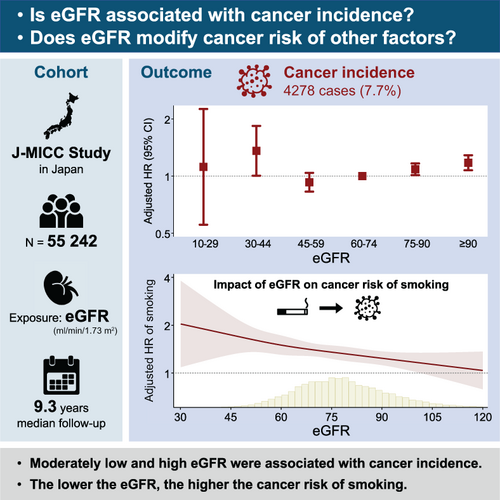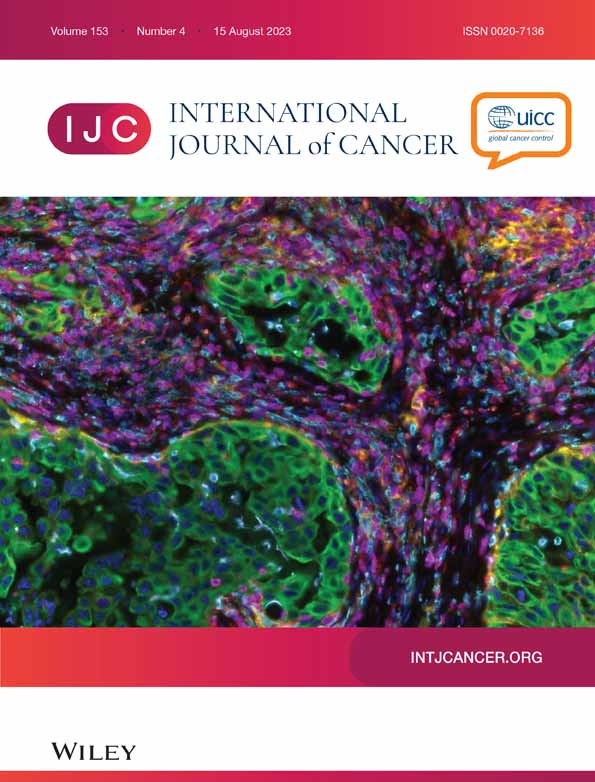Association of kidney function with cancer incidence and its influence on cancer risk of smoking: The Japan Multi-Institutional Collaborative Cohort Study
Abstract
The association between kidney function and cancer incidence is inconsistent among previous reports, and data on the Japanese population are lacking. It is unknown whether kidney function modifies the cancer risk of other factors. We aimed to evaluate the association of estimated glomerular filtration rate (eGFR) with cancer incidence and mortality in 55 242 participants (median age, 57 years; 55% women) from the Japan Multi-Institutional Collaborative Cohort Study. We also investigated differences in cancer risk factors between individuals with and without kidney dysfunction. During a median 9.3-year follow-up period, 4278 (7.7%) subjects developed cancer. Moderately low and high eGFRs were associated with higher cancer incidence; compared with eGFR of 60-74 ml/min/1.73 m2, the adjusted hazard ratios (HRs) (95% confidence intervals [CIs]) for eGFRs of ≥90, 75-89, 45-59, 30-44 and 10-29 ml/min/1.73 m2 were 1.18 (1.07-1.29), 1.09 (1.01-1.17), 0.93 (0.83-1.04), 1.36 (1.00-1.84) and 1.12 (0.55-2.26), respectively. High eGFR was associated with higher cancer mortality, while low eGFR was not; the adjusted subdistribution HRs (95% CIs) for eGFRs of ≥90 and 75-89 ml/min/1.73 m2 were 1.58 (1.29-1.94) and 1.27 (1.08-1.50), respectively. Subgroup analyses of participants with eGFRs ≥60 and <60 ml/min/1.73 m2 revealed elevated cancer risks of smoking and family history of cancer in those with eGFR <60 ml/min/1.73 m2, with significant interactions. Our findings suggest that the relationship between eGFR and cancer incidence was U-shaped. Only high eGFR was associated with cancer mortality. Kidney dysfunction enhanced cancer risk from smoking.
Graphical Abstract
What's new?
Despite suspected associations between chronic kidney disease and cancer, it remains unknown whether kidney function modifies cancer risk. Moreover, the majority of studies examining possible associations have involved Caucasian populations, with limited investigation particularly of Asian groups. The present analysis explored potential links between kidney function and cancer among Japanese patients. Analyses reveal a U-shaped relationship between estimated glomerular filtration rate (eGFR) and cancer incidence, wherein cancer risk was elevated in association with moderately low and high eGFR. Cancer risk from smoking increased as eGFR decreased, highlighting the importance of avoiding smoking, especially in the context of reduced kidney function.
CONFLICT OF INTEREST
The authors declare no potential conflicts of interest.
Open Research
DATA AVAILABILITY STATEMENT
Anonymized data that are minimally required to replicate the outcomes of the study will be made available upon reasonable request to the corresponding author, and following approval from Nagoya University Graduate School of Medicine, the Ministry of Health, Labor, and Welfare, Japan and the National Cancer Registry, Japan.





